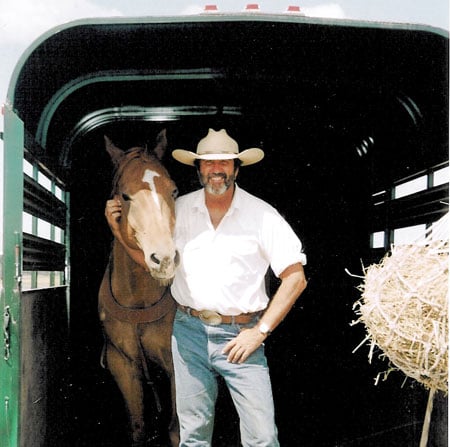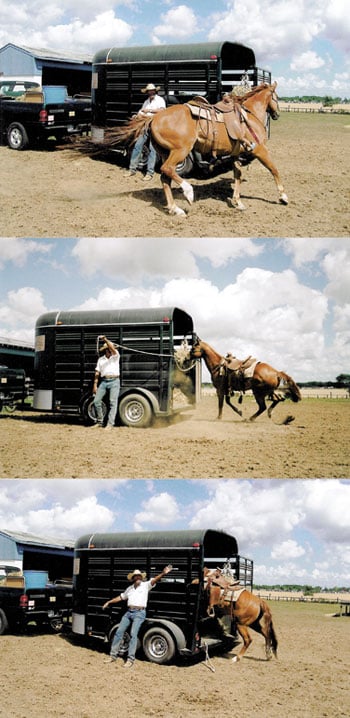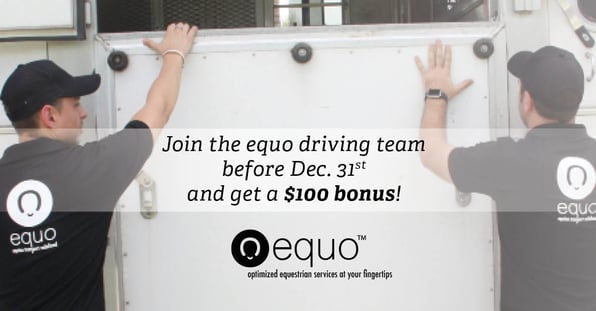Horses are born genetically hardwired to resist going into trailers. Not knowing this fact is the number one reason most people have difficulty loading their horse. To a horse, a horse trailer looks like a big metal cave on wheels. Horses know that predators (mountain lions, bob cats, and wolves) that eat prey (horses) live in caves (horse trailers). It’s not only unnatural; it’s life threatening for a horse to go into a cave or a horse trailer.
 It’s not about trailer loading, it’s about the relationship. ©Tim Hayes
It’s not about trailer loading, it’s about the relationship. ©Tim Hayes
Trailer loading problems can occur at different times for different reasons in the life of a horse. The two primary causes of resistance are fear or disrespect.
Fear
Horses that have either never gone into a horse trailer or those that have never been taught to feel safe and comfortable in one, both physically and emotionally, are usually going to resist. The reason is fear. Horses are claustrophobic. They naturally know to avoid confined places that inhibit their ability to escape from danger. If they feel forced to go into a trailer they will refuse as is their life depended on it. In their mind, it does. And to make the situation worse, they don’t understand why their partner/leader/best friend (i.e. you), doesn’t know this.
Disrespect
Horses who are not afraid and have learned to go into trailers will sometimes refuse out of disrespect. They have not yet accepted their human as the leader. They will resist as their way of establishing themselves as the leader of the pecking order in a herd of two—themselves and their human. Whether it’s fear, disrespect, or a combination of both, the solution is the same—leadership.
The following are the 6 Steps of Natural Horsemanship Trailer Loading*
1. First establish yourself as a respected leader with the horse.
You communicate in the horse’s natural language to become its leader. This is accomplished over time with a series of groundwork exercises. Using body language, touch, and feel, administer levels of physical discomfort (not force, fear, or pain) to motivate your horse to willingly move his feet. After he moves, give him comfort by allowing him to rest. Learning how to communicate with your horse with these techniques is something that can be taught and that you can learn from a qualified teacher.
*(Note. If a horse seems to fluctuate between fear and assertive disrespect, teaching him can become quite tricky and will sometimes require professional assistance).
2. Communicate loading with levels of comfort and discomfort.
After you have established yourself as your horse’s leader on the ground, use the same principles for asking him to move into the trailer. Make the desirable behavior (going into the trailer) comfortable and the undesirable behavior (staying outside) uncomfortable.
Learn and use the effective natural methods of increasing and decreasing varying degrees of pressure. This can be accomplished by using your lead rope with various techniques. These will enable you to make your horse uncomfortable without becoming fearful, angry, or resentful. As soon as your horse just tries moving forward, reward him by taking the pressure off and letting him rest (comfort). Then repeat going a little further each time.
Don’t wait until you have to take your horse somewhere. Start practicing months before when there’s no pressure. You don’t have to complete the whole process in one session. Some horses take longer than others. You can do it over a couple of hours, days, weeks, or months. Always stop on a good note and come back when you’re ready to begin again.
3. Do not use force, punishment, or pain.
When a horse is afraid to go into a trailer, using any type of force (three people pushing, one pulling, or pulling him with a rope behind his butt, etc.) will cause the horse to become more fearful and increase his resistance. (For example, your friend tells you to jump off the high diving board. You tell him you’re afraid and you don’t want to. He says there’s nothing to be afraid of and starts to pull you out to the end. You use all your strength to resist and become angry with your friend for not listening and forcing you).
The worst thing you can do is hit your horse. It convinces him his instinctual fear was correct. Now he’s not only fearful about the trailer, he’s experiencing pain, which he immediately associates with the trailer. This then increases his level of fear and resistance to going into the trailer.
4. Do not trick or bribe the horse.
Using bribes (food, treats) to obtain desirable behavior from a horse is totally counter productive and usually ineffective. Horses do not consider food a reward. In fact, when they are afraid, they will not eat in order to have a lighter stomach, enabling them to run further and faster. Natural rewards for horses are rest and reassurance (petting, stroking). Whether it’s horses or children, using bribes to get what you want is dishonest, manipulative, and destroys the foundation of all healthy relationships—love, trust, and respect.
5. Use positive patient persistence and stay on horse time.
Horses have no concept of elapsed time. They live in the moment. In order to stay relaxed and calm while being assertive, we must also have no schedule and live in the moment.
Both humans and horses learn by:
- Advancing outside of their comfort zone
- Remaining here as long as possible
- Retreating back inside their comfort zone
When it’s time to begin, don’t lead your horse into the trailer. Stay outside the trailer and direct him forward (drive him) into the trailer. It helps your horse become more confident and it’s much safer for both of you. Repeatedly ask the horse to advance a little beyond his comfort zone (into the trailer). Allow him to stay as long as he can. Allow him to retreat back into his comfort zone (outside the trailer) reassuring him as he continues.
If you patiently persist with no predetermined agenda (“I have to get my horse in the trailer now!”), his comfort zone will increase in size until it becomes the whole trailer!
Note: Once he finally goes in, don’t put up the butt bar or close the door. Allow him to go in and out many times until he will stay inside totally relaxed without stepping out for at least 60 seconds. Then make noise and rattle the chains. If he continues to stand calmly inside the trailer, then close it up.
6. Teach your horse to load himself for life.
Usually, the first time you put a saddle on a horse’s back he’s anxious, suspicious, will often move, and buck it off. Not long after, it becomes a non-issue. Saddling your horse becomes as second nature for him as being turned out to pasture. The same is true for natural trailer loading.
Don’t teach your horse to trailer load so you can get him to the show. Teach him so it becomes one of the many things he learns to do in the human world and something he’s happy to do for his partner.
Natural trailer loading is not about getting your horse into the trailer. It’s about your relationship with your horse. The principals of love, trust, and respect are more important than the purpose of taking your horse somewhere in a trailer. Your horse knows the difference. You’ll see the difference.
 Step 6: Teach your horse to load himself. ©Tim Hayes
Step 6: Teach your horse to load himself. ©Tim Hayes
About the Author
Tim Hayes is the author RIDING HOME: The Power of Horses to Heal. It is this amazing power of horses to heal and teach us about ourselves that is accessible to everyone and found in the pages this book. Every book ordered will benefit veterans with PTSD, children with autism, and children of families in need. Learn more at ridinghome.com. For Tim’s clinics, private sessions, books, DVD’s and more articles go to Hayesisforhorses.com



